When we first arrived in Egypt this winter, a trip along the southern part of the Ring Road revealed a massive construction project to widen the ring from an official 3 or 4 lanes in each direction to 7 or 8 lanes. Since official painted lanes don't mean much in Egypt amidst heavy traffic, I attempted to count the number of lines of vehicles moving in either direction a few times. I maxed out at twelve but felt there was room for more!
This is certainly a wide expanse of pavement.

Since the project is incomplete at this time, traffic jams up considerably as the completed "8-lane" sections narrow down to "4-lanes." This stretch of the ring coming down from the Muqattam hills to the bridge across the Nile, shows work in progress and traffic not much in progress.

When the Ring Road was originally constructed, it only comprised three-quarters of a ring due to concerns about potential damage to historic sites. Modifications to the original design were then made and a diverted ring was closed "by building a road over the Marioteya waterway." That quote is taken from the Wikipedia entry for Ring Road (Cairo) and unfortunately, the two attached footnote links lead to non existent web pages.
We are quite familiar with that north-south road over the Marioteya waterway, however. It lies just beneath our living room window.
These pictures show the original version under construction in 2008 and the completed version in 2020.
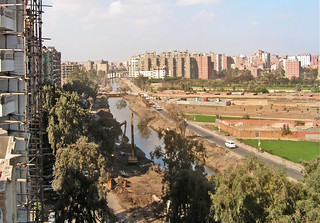
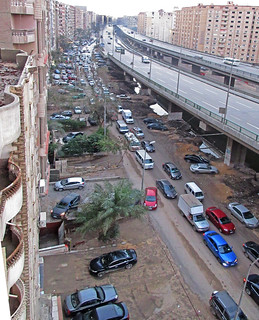
By this year, the local access road had been changed and both parking areas and pedestrian access are much improved.
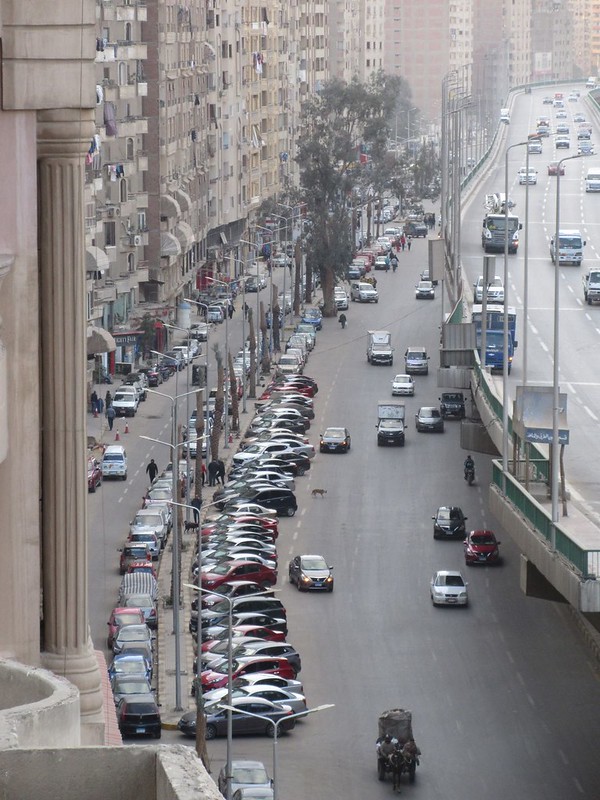
We can even walk over a pedestrian bridge that crosses the Marioteya waterway to some new restaurants on the far side and see a fountain in a mini-park along the way. Perhaps next year the fountain will even be operating.
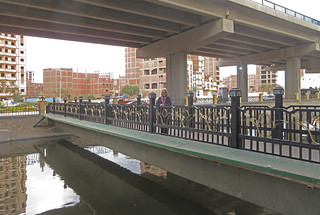

If the widening of The Ring was a surprise to us, it was nothing compared to the discovery of a new, wide, boulevard south of Pyramids Street that includes a very elevated bridge over the elevated north-south road above the Marioteya waterway. Now, I can't say for certain that this new boulevard, known as Anwar El-Sadat Street, was built through the exact neighborhood shown below on the left, but it does pass through some very similar territory as it heads west toward the Great Pyramids of Giza. Construction of this road took place in a remarkably short time - about eight months concluding in August of 2021.
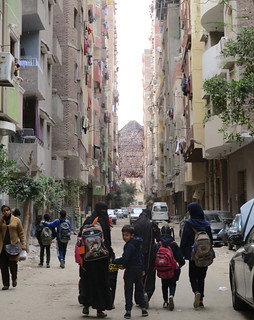
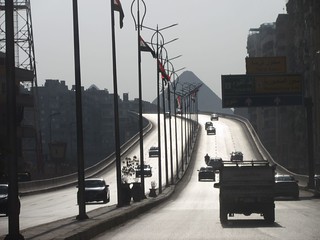
How does all of this progress occur in a densely populated metropolis like Cairo? Very rapidly and with a lot of displacement of established homes and businesses and a lot of money - although very cheap by U.S. standards. The new Anwar El-Sadat street comes in at 100 million EGP, about $6 million U.S. Dollars and the total for the Ring Road expansion is pegged at $408 million for around 60 miles. (widening I-494 in Bloomington, MN, from 169 to the airport is forecast at over $300 million and planned for four years of construction, 2023-2026).
Here are a few links and quotes about the road construction. The most notable feature is the inclusion of a Bus Rapid Transit Lane - a very modern thought! Note that the work is being accomplished largely by Egyptian contractors; the "road above the Marioteya waterway" was built by French contractors.
Note also the displacement of residents. I will come back to that in the next post.
From World Highways:
Upgrading work is being carried out on Cairo’s Ring Road. The project is needed to cope with Egypt’s fast growing population and the city’s increasing vehicle numbers.
Congestion is a frequent problem on Cairo’s road network and the city is notorious for its lengthy traffic delays at peak periods. The Ring Road widening work is intended to boost capacity and cut journey times, as well as helping to boost safety for users.
The work is costing over US$408 million and 106km of the Ring Road will be widened. At present the route features four lanes in either direction. However, the plan is to increase the width of the Ring Road to a minimum of seven lanes in either direction and eight lanes in either direction for the sections currently suffering the worst delays at peak periods.
Included in the work is the widening of the Autostrad Bridge by some 30%, while the Mounib Bridge is also being widened as part of the project. In addition, Egypt’s Ministry of Transport intends to include dedicated lanes for a Bus Rapid Transport (BRT) system for the project.
However, the construction of a new overpass in Giza has been the subject of controversy due to its extremely close proximity to residential buildings.
Anwar El Sadat road axis project
The construction of the axis of Anwar El-Sadat Road parallel to Haram Street, at 100 million pounds, will ease traffic in the areas of Munib, Faisal, Saft El Laban, Bragil, and Maidan The League of Arab States in Giza, and will reduce confusion on Haram Street, which will be partially closed during the implementation of the Cairo metro project's fourth phase.
The building work is overseen by the engineering department of the military forces and carried out by the Arab Contractors Company, as well as a few small businesses. The Anwar Sadat Road axis was finished in August 2021, after construction began in the first quarter of that year. The Sadat axis stretches for 2.7 kilometers.
The Official Gazette published in its issue issued today, Saturday, the decision of Dr. Mustafa Madbouly, Prime Minister, No. 2651 of 2020 regarding the expropriation of real estate inconsistent with the Muhammed Anwar Sadat Axis project, “a former terrace” in Giza Governorate ...
... The second article also stipulated that the lands and real estate necessary for the implementation of the project referred to in the previous article shall be seized by direct implementation, and their location, borders and apparent owners are indicated
The number of buildings being demolished in order to expand and upgrade Greater Cairo's Ring Road is 390 so as compensations will be disbursed to 1,380 families, 296 shop owners, and 136 workshop owners in Basatin neighborhood, Deputy Cairo Governor Gihane Abdel Moneam told Al Watan newspaper Monday.
It is noted that the construction and electrification works were supposed to finish in 2020 but got delayed because of the census conducted to identify the buildings that must be demolished, and hence, owners who have to be compensated.
The bus rapid transit portion of the project is discussed in an article in Enterprise Press. It details some of the problems with the current Microbus system.
What does our current transit landscape look like on the Ring Road: While sometimes dangerous and unreliable, microbus use in Cairo is currently an essential component of our transit infrastructure. Specific numbers are hard to come by for the Ring Road but two-thirds of all public transit use in the Greater Cairo region relies primarily on microbus travel, Mohamed Hegazy, director of urban transit research and consultancy firm Transport for Cairo (TfC), tells us. “Microbuses are fast and often provide a direct service to places where formal alternatives would require an interchange,” Hegazy says, which a majority of riders value over having to make multiple transit changes, he explains.





No comments:
Post a Comment